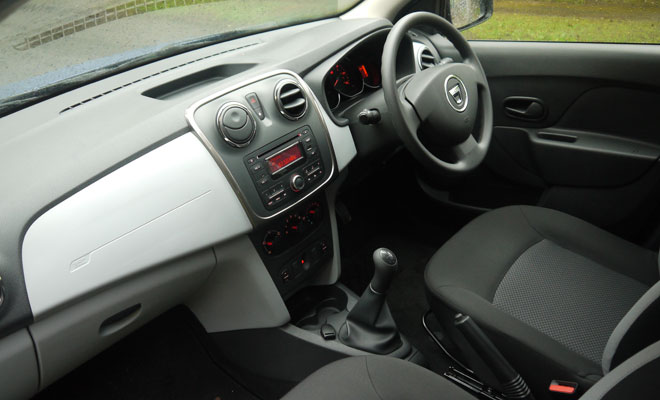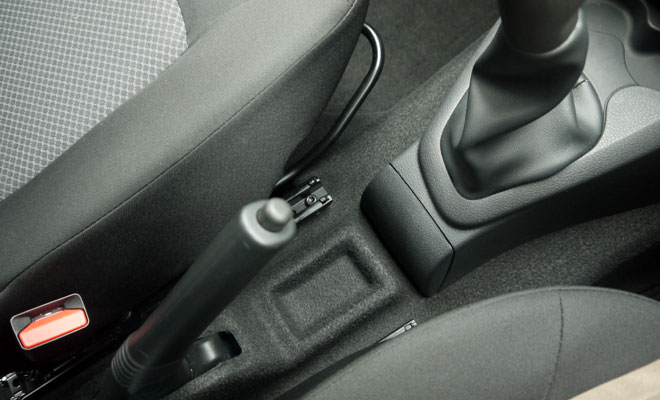by Lem Bingley 
Admittedly it only feels like 1985 inside. That’s roughly the era when the Dacia’s interior might have seemed vaguely impressive. It has electric windows, for example. The switches are mounted low in the centre console, and you need to keep your finger planted all the way up or down, but they are electric. The door mirrors, by contrast, aren’t.

All of which sounds like criticism but is not meant to be. Most of today’s cars are extremely complicated, with lots of components they could probably do without – step forward those electric servomotors to adjust the mirrors. Every component has to be designed, fabricated from raw materials and shipped to the factory for assembly. Each adds weight and sucks ups energy. A simpler, back to basics approach ought to be greener.
Last year, Dacia’s parent company Renault made public a very detailed study assessing the carbon footprint of one of its models from conception to disposal. The report, vetted by independent specialists in lifecycle impact, assessed every nut and bolt of Renault’s budget Fluence saloon, in diesel, petrol and electric editions.
For the two conventional Fluences, the report concluded that the equivalent of about five tonnes of CO2 is released for every example that reaches the forecourt. That’s then followed by a usage impact of about 20 tonnes for diesel and 28 tonnes for a petrol car, over a lifetime of 150,000km. Trimming the initial carbon count could be significant, in other words, especially for owners who clock up lower mileages.

I have no figures for the carbon debt of the Romanian-built Logan, but it has to be less than average for a new car. All the more so because the Logan is based on recycled technology – with major pieces of ironmongery borrowed wholesale from earlier Renaults. The Dacia is also relatively light at just over a tonne, or about 20% lighter than a Megane estate.
Fortunately Dacia hasn’t travelled too far back in time to source the engines for the Logan estate (or Maximum Capacity Vehicle, if you’re wondering what MCV stands for). The 900cc, three-cylinder turbo petrol engine in my test car is borrowed from the current Clio – minus expensive features such as automatic stop-start.
With a modest 90 horsepower on offer, the TCe engine can still haul the big boxy Logan to 62mph in 11.1 seconds. Combined-cycle economy is rated at 56.6mpg and CO2 at 116g/km. I can’t say what consumption I’ve managed to achieve as there’s no trip computer cluttering up the instruments.

There is also a cheaper, slower, less economical and considerably more ancient 1.2-litre petrol option, or a reasonably modern 1.5-litre dCi 90 diesel that delivers a tolerable 12.1-second gallop to 62mph, while promising 74.3mpg and a competitive 99g/km.
On the road, behind the Logan’s rubbery, button-free wheel, things do feel a little institutional. There’s no mistaking the budget nature of the beast. You sit surrounded by hard grey plastic, and the nearest I’ve come to surprise or delight is laughing at the coin tray (I assume) moulded into the cheap grey carpet under the handbrake.

The Logan’s interior is not without appeal, however, particularly when you assess how few things there are to go wrong. There aren’t many places for a gremlin to hide, and as a result not a single thing rattles over bumps.
The suspension feels decently sorted too and the utter lack of sporting stiffness comes as a blessing given that we’re not going anywhere fast. It’s reassuring to note that a modern ESP system is fitted to all editions of the Logan MCV, and that the brakes feel both firm and progressive.
Noise is surprising modest for such a big, bluff-looking car. There’s a busy murmur from wind and tyres, a throaty rasp from the three cylinders up front, but the total is never overbearing. The whole body does boom and shudder a bit over big bumps, however.

My main source of gripes is the five-speed manual transmission. The stick feels much like a screwdriver poked into bucket full of gravel, providing a loose, rattly sensation with every throw. And there’s not enough room down among the pedals for both my feet. I’m not keen on having to wrestle my toes out from under the clutch every time I need to swap cogs. No doubt things all fitted neatly in the left-hand-drive edition, but the UK pedal box is distinctly below par.
The seat won’t adjust for lumbar or height but it does feel pretty supportive, and there’s decent legroom in the back. The boot is simply huge, and one throwback I’m always happy to see is a proper spare wheel under the floor – yours as an option for £95. The tailgate, incidentally, can be opened remotely from the driver’s seat, by pulling a little lever that tugs a cable running under the carpet.
Naturally, all this low-tech or no-tech stuff contributes to the Logan’s most unique and outstanding feature: its price. The cheapest Logan MCV costs from £6,995, while the mid-range version I tried starts from £8,595.
Like much of the car itself, that’s a price that seems to belong to some long forgotten year in the past, when life was simpler – and a lot cheaper.


Dacia Logan MCV
Rating: stars
Good: simple, sturdy and extremely cheap
Bad: cramped pedals, low-rent ambience
Price: from £6,995
Today my means of transport is an oblong blue box that’s cavernous on the inside and can whisk me back to 1985. Not actually Dr Who’s Tardis, but a Dacia Logan MCV. Rating: stars
Good: simple, sturdy and extremely cheap
Bad: cramped pedals, low-rent ambience
Price: from £6,995
Admittedly it only feels like 1985 inside. That’s roughly the era when the Dacia’s interior might have seemed vaguely impressive. It has electric windows, for example. The switches are mounted low in the centre console, and you need to keep your finger planted all the way up or down, but they are electric. The door mirrors, by contrast, aren’t.

All of which sounds like criticism but is not meant to be. Most of today’s cars are extremely complicated, with lots of components they could probably do without – step forward those electric servomotors to adjust the mirrors. Every component has to be designed, fabricated from raw materials and shipped to the factory for assembly. Each adds weight and sucks ups energy. A simpler, back to basics approach ought to be greener.
Last year, Dacia’s parent company Renault made public a very detailed study assessing the carbon footprint of one of its models from conception to disposal. The report, vetted by independent specialists in lifecycle impact, assessed every nut and bolt of Renault’s budget Fluence saloon, in diesel, petrol and electric editions.
For the two conventional Fluences, the report concluded that the equivalent of about five tonnes of CO2 is released for every example that reaches the forecourt. That’s then followed by a usage impact of about 20 tonnes for diesel and 28 tonnes for a petrol car, over a lifetime of 150,000km. Trimming the initial carbon count could be significant, in other words, especially for owners who clock up lower mileages.

I have no figures for the carbon debt of the Romanian-built Logan, but it has to be less than average for a new car. All the more so because the Logan is based on recycled technology – with major pieces of ironmongery borrowed wholesale from earlier Renaults. The Dacia is also relatively light at just over a tonne, or about 20% lighter than a Megane estate.
Fortunately Dacia hasn’t travelled too far back in time to source the engines for the Logan estate (or Maximum Capacity Vehicle, if you’re wondering what MCV stands for). The 900cc, three-cylinder turbo petrol engine in my test car is borrowed from the current Clio – minus expensive features such as automatic stop-start.
With a modest 90 horsepower on offer, the TCe engine can still haul the big boxy Logan to 62mph in 11.1 seconds. Combined-cycle economy is rated at 56.6mpg and CO2 at 116g/km. I can’t say what consumption I’ve managed to achieve as there’s no trip computer cluttering up the instruments.

There is also a cheaper, slower, less economical and considerably more ancient 1.2-litre petrol option, or a reasonably modern 1.5-litre dCi 90 diesel that delivers a tolerable 12.1-second gallop to 62mph, while promising 74.3mpg and a competitive 99g/km.
On the road, behind the Logan’s rubbery, button-free wheel, things do feel a little institutional. There’s no mistaking the budget nature of the beast. You sit surrounded by hard grey plastic, and the nearest I’ve come to surprise or delight is laughing at the coin tray (I assume) moulded into the cheap grey carpet under the handbrake.

The Logan’s interior is not without appeal, however, particularly when you assess how few things there are to go wrong. There aren’t many places for a gremlin to hide, and as a result not a single thing rattles over bumps.
The suspension feels decently sorted too and the utter lack of sporting stiffness comes as a blessing given that we’re not going anywhere fast. It’s reassuring to note that a modern ESP system is fitted to all editions of the Logan MCV, and that the brakes feel both firm and progressive.
Noise is surprising modest for such a big, bluff-looking car. There’s a busy murmur from wind and tyres, a throaty rasp from the three cylinders up front, but the total is never overbearing. The whole body does boom and shudder a bit over big bumps, however.

My main source of gripes is the five-speed manual transmission. The stick feels much like a screwdriver poked into bucket full of gravel, providing a loose, rattly sensation with every throw. And there’s not enough room down among the pedals for both my feet. I’m not keen on having to wrestle my toes out from under the clutch every time I need to swap cogs. No doubt things all fitted neatly in the left-hand-drive edition, but the UK pedal box is distinctly below par.
The seat won’t adjust for lumbar or height but it does feel pretty supportive, and there’s decent legroom in the back. The boot is simply huge, and one throwback I’m always happy to see is a proper spare wheel under the floor – yours as an option for £95. The tailgate, incidentally, can be opened remotely from the driver’s seat, by pulling a little lever that tugs a cable running under the carpet.
Naturally, all this low-tech or no-tech stuff contributes to the Logan’s most unique and outstanding feature: its price. The cheapest Logan MCV costs from £6,995, while the mid-range version I tried starts from £8,595.
Like much of the car itself, that’s a price that seems to belong to some long forgotten year in the past, when life was simpler – and a lot cheaper.




